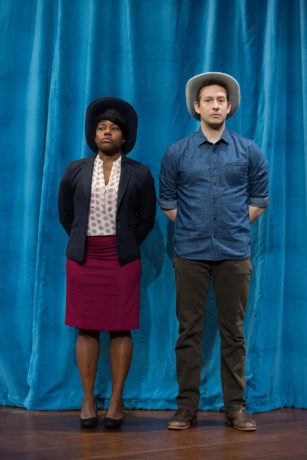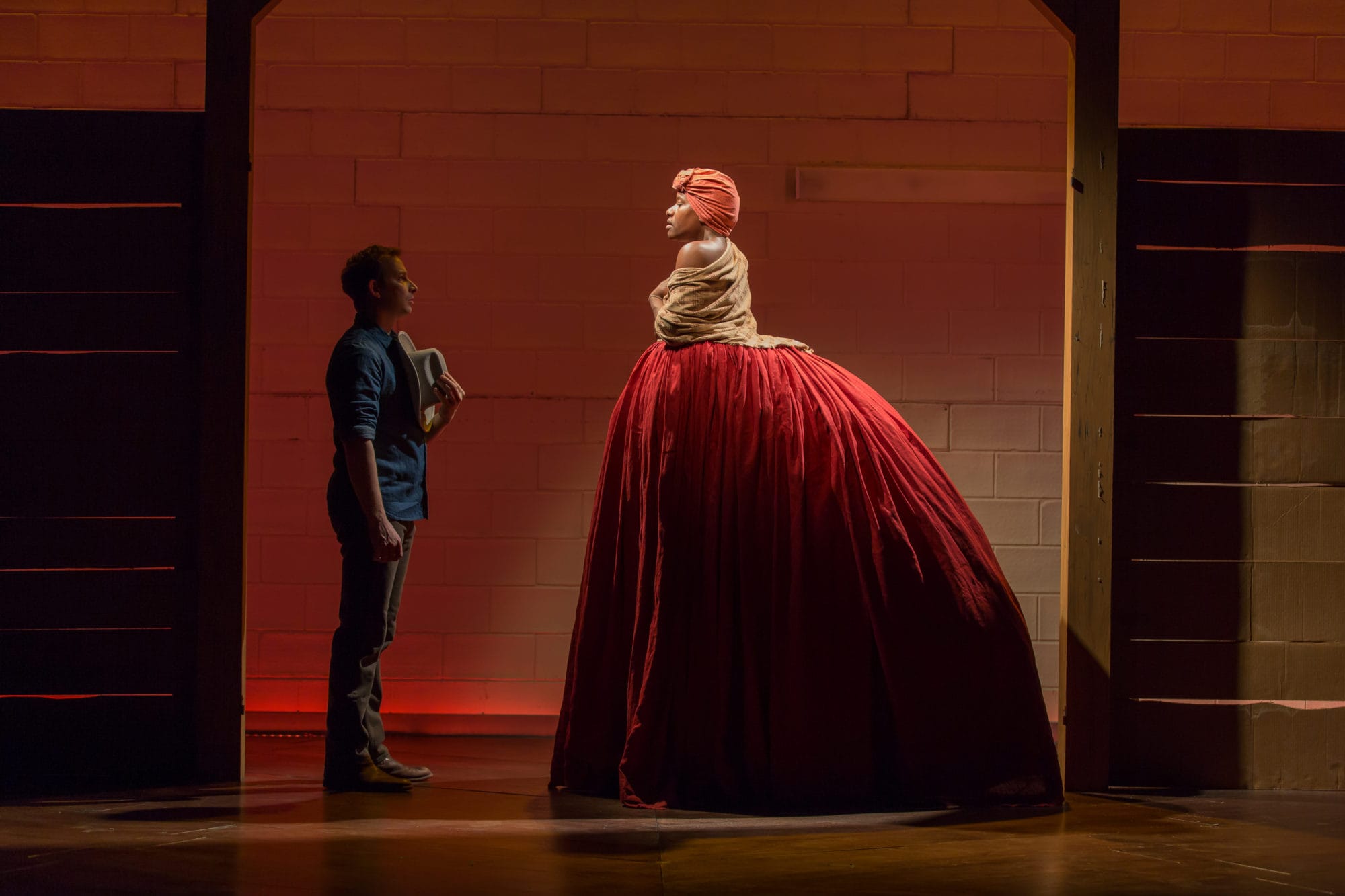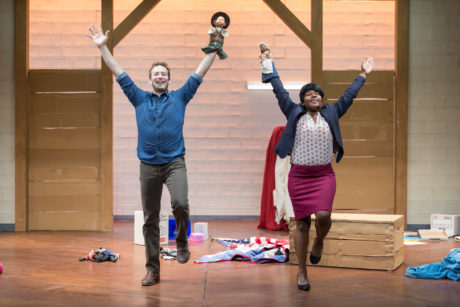“What the fuck was that?” a friend asked me at the opening night reception for this show at Woolly. To which, still reeling, I could only answer, “Yeah, what the fuck?”
The cringe-inducing show we had just seen is misleadingly titled Underground Railroad Game. Created and performed by Jennifer Kidwell, who is black, and Scott R. Shepard, who is white, it begins in the guise of a lesson for middle-schoolers about the history of slavery. There is a brief enactment set in a barn in which Kidwell plays a runaway slave and Shepard plays a Quaker Abolitionist. Then there’s a scene change to a classroom and Kidwell and Shepard appear as Teacher Caroline and Teacher Stuart. A school bell clangs, and they address us the audience as middle-schoolers while they give us instructions for a live-action educational role play: Under each of our seats we are to find a blue or gray toy solder, which splits us into a Union army and a Confederate army. Now we are contestants in a game that involves the blue team rescuing black rag dolls and the grey team capturing the same dolls and returning them to their masters.

It’s a funny, enjoyable bit, an overtly ironic take on how the underground railroad functioned. (It echoes the wonderful metatheatricality of Brandon Jacobs-Jenkins’s extraordinary An Octoroon, recently revived at Woolly.) And Kidwell and Shepard are both appealing and engaging performers. They win over the audience with ease.
Before long the show takes an unexpected turn. Teacher Caroline and Teacher Stuart begin a romantic relationship. They take walks together. They hold hands. Their talk turns sexual. She tells him a joke about a child who took her cat to school. Asked why, the child said she heard her father tell her mother, “Soon as that child leaves, I’m gonna eat dat pussy.” The humor continues in that un-PC vein. And the play explicitly plays with the racial difference between the two. There are thus a lot of awkward moments in their interaction that, as evidently intended, the audience recognizes and finds funny.
(At this point the quickwitted badinage between Kidwell and Sheppard reminded me a lot of early Mike Nichols and Elaine May routines. And I sensed in the house the familiar uneasy amusement one hears when mainly white DC audiences chuckle nervously whenever a play plays the race card for laughs.)
So far so good. Two teachers, one black and one white, plausibly entering into a personal, probably sexual relationship outside the classroom.
But then the show transforms into something else. We see these two people’s sexual relationship acted out on stage. At one point she, wearing a gown with an oversize skirt, deliberately bares her breasts and he luxuriates in kissing one. It is not clear just now who she is or who he is. (Rhett Butler making out with a ball-gowned Mammy, to flip the Tara plantation narrative? No idea.) Thereafter at her invitation, he crawls under her enormous skirt and, as we are given to understand from her orgasmic moans, does eat her pussy.

This inscrutable erotic tableau then segues into graphic raceplay. I name it raceplay because at no point in the sex scenes we see performed is the eroticization of her race outside their equation. And we get quite some eye-popping sights of their roleplaying: bondage, discipline, dominance and submission, together with intense fight choreography. In what may have been intended as fair-play turnabout, she strips him naked, slaps a ruler against his behind leaving his butt cheeks red, and then uses the same ruler to diddle his dick. Whether we are to understand that he during this session with this black dominatrix is somehow dealing with his white guilt, I cannot guess. There are not many narrative clues to go on. There’s just a long scene of raceplay.
I’ll pause now to say that if what I have just described is something you would buy a ticket for to see with your own eyes, you may appreciate this show.
I’ll also add that at no point was there any hint that Kidwell and Sheppard’s roleplaying was anything but consensual. The two have been working together on this show for five years and they devised everything in it. No alarms went off that Not In Our House ought to hear. Yet the audience seemed stunned into silence, dumbfounded in discomfort. I myself felt as if as if my consent had been trespassed.

Then somehow as if in a blur the show went blithely on. The raceplay ended, the performers returned to their chipper personas as Teacher Caroline and Teacher Stuart, we were back in the garishly lit classroom, and we were all regaled as if what had happened had not happened.
It was a lurch I could not go along with; nor could I at the end join the standing ovation. I was undone. I needed time to process this disconcerting show. It was weird to be expelled from the theater without the opportunity for a talkback.
Eventually, as I mulled on my own, two questions came to me:
Question 1: Had I just been gulled into a very personal and graphic exploration of how the history of chattel slavery in America has inspired, for some willing partners in interracial relationships, the vocabulary and transactions of sadomasochism? I know, for instance, that in BDSM (bondage/discipline/sadism/masochism), so-called slave training is a thing. So I do not doubt that among the residues of slavery has been such adulteration of intimate relationships. Nor, for that matter, do I doubt that some people replay aspects of the history of the Holocaust to get their rocks off. Human sexuality is vastly malleable in what it can eroticize, and online pornography has become the Amazon.com of kink. For some people hierarchy is hot; I get that. That’s one of the reasons unjust hierarchies persist. But I’m fine reading about this, thank you very much. Don’t need it thrust in my face unawares.
Question 2: Had I just watched the history of chattel slavery in America be rewritten and treated pedagogically as an S&M scene? Like, with blacks and whites all consenting adults getting off on it? Like, erasing all the eroticized race hate and woman hate it took to drive the historical reality of rape—displacing all that in our minds, helping us not have to think about it, giving us instead an unforgettable mental picture of S&M raceplay, which, however discomfiting actually functions as a comforting distraction from the horrific reality that happened and is still happening?
If the answer to Question 1 is yes: Underground Railroad Game needs a content warning: “This show graphically dramatizes how the history of slavery in America has become for some people a sexual fetish.”
If the answer to Question 2 is yes: Underground Railroad Game needs a conscience warning: “This show graphically demonstrates how in a city like DC, with all the stories about racism that need to be told, one otherwise highly respected theater company has chosen to produce some of the most morally oblivious drivel since minstrelsy.”
________
One more advisory: Connecting to the show’s thematic undertone vis a vis the sexualization of race—in particular, what it means for black women—there is a display in the Woolly lobby of antique black dolls. Their skirts are spread wide open, and each doll is mounted on a pedestal with an angled mirror beneath it such that one can snatch an upskirt view.
Running Time: 90 minutes, with no intermission.
Underground Railroad Game plays through April 29, 2018, at the Woolly Mammoth Theatre Company – 641 D Street, NW, in Washington, DC. For tickets, call (202) 393-3939, or purchase them online.





